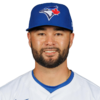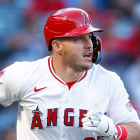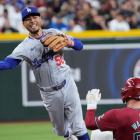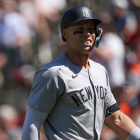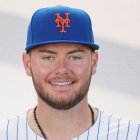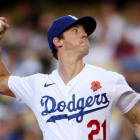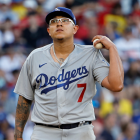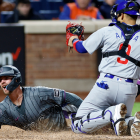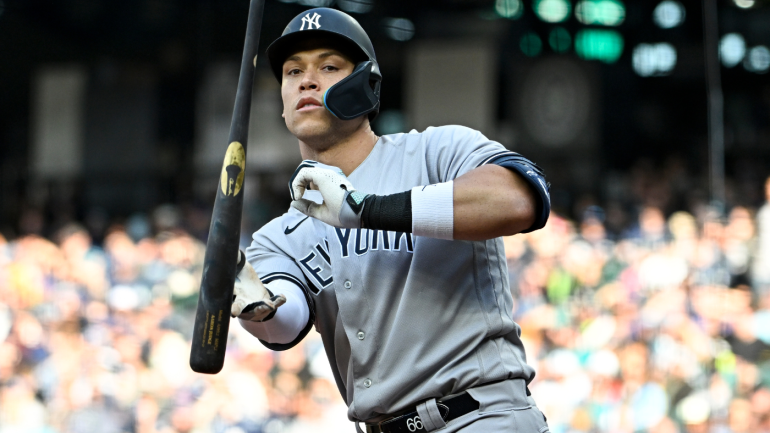
What a difference a month can make in this game. On May 1, the New York Yankees were 15-15 with a run differential (plus-1) that supported their .500 record. Now, as May comes to a close, the Yankees have the fifth-best record (34-23) and sixth-best run differential (plus-41) in baseball. Tuesday's win (NY 10, SEA 2) was New York's MLB-leading 19th in May.
The single biggest reason for the Yankees' May turnaround is Aaron Judge. The reigning AL MVP returned from a minor hip issue on May 9 and has since hit a staggering .356/.484/.918 with 12 home runs in 20 games. Very few players in this sport can take over a game by themselves and Judge is among them. Monday night he hit two homers and a robbed a homer:
"It's one of the great individual games you'll see," Yankees manager Aaron Boone told MLB.com about Judge's effort. "Two homers, take one back, double, walk. What a day. I mean, what do you say?"
Getting Judge back has obviously helped. So too have the returns of Harrison Bader and Luis Severino, continued excellence from Anthony Rizzo, timely hits from Isiah Kiner-Falefa, surprising production from Willie Calhoun, and a bullpen that has been among the game's best despite not having a designated closer. Simply put, the Yankees are playing better all-around team baseball.
The Yankees entered the month with a .500 record and they're now on pace to win 97 games, which is obviously great. The problem is a 97-win pace puts you in third place in the AL East this season. As good as the Yankees were in May, they gained only 3 1/2 games on the Tampa Bay Rays. There's still plenty of time to chip away, but yeah, this division is a beast.
Strong May aside, the Yankees still aren't firing on all cylinders, and there are several areas on the roster that can be improved. Here are five things that must happen for the Yankees to build on these last few weeks to solidify their spot in the postseason race, possibly challenge for the AL East title, and put themselves in the best position for October.
1. Judge has to keep it up
Will Judge continue to hit 12 home runs every 20 games like he has since returning from the injured list? Nah, I doubt it. That's a lot of dingers. But can he hit sustain his .303/.413/.691 slash line all season? I mean, why not? Judge hit .311/.425/.686 across a full season a year ago and his contact quality (exit velocity, barrel rate, etc.) this year is actually better than last year. He's in his prime, he's healthy (as far as we know), and he's motivated. Either way, the Yankees need Judge to remain a top-of-the-league performer to have their best chance at success. To paraphrase another iconic Yankees right fielder, Judge is the straw that stirs the drink.
2. They need to get healthy
This is not unique to the Yankees. Every single team deals with injuries -- this season already feels like one giant war of pitching attrition league-wide -- and the teams that best cover for their injuries are usually among those left standing in October. That doesn't mean the Yankees or any other team can't hope to get healthy though. Everyone wants to be at 100%.
Judge (hip) and Severino (lat) returned earlier this month. Bader (oblique) did as well, though he played only 26 games before hurting his hamstring trying to beat out an infield single Monday. So even when one player gets healthy, another goes on the injured list. Fortunately for the Yankees, they have more help coming. These returns are all tentative:
- Friday: Josh Donaldson (hamstring) and Tommy Kahnle (biceps)
- Next week: Giancarlo Stanton (hamstring)
- Mid-June: Ian Hamilton (groin)
- Early-to-mid July: Carlos Rodón (forearm, back)
Hamilton is not a big name, certainly not on this roster, though he emerged as a trusted bullpen arm prior to his injury two weeks ago, and his loss has been felt. Kahnle will give the Yankees another bullpen option, Stanton hit four homers in 13 games before going on the injured list, and Donaldson remains a difference-making defender even though his bat has slowed.
Then there's Rodón, who has yet to pitch this season after signing a six-year, $162 million free-agent contract over the winter. He suffered a forearm strain in his first spring training start, and once that healed and he began his rehab work, his back tightened up. Rodón received a cortisone shot two weeks ago and has started throwing bullpen sessions as he works his way back.
"I just tried to attack the zone, even though no one was standing in," Rodón told MLB.com about Monday's 20-pitch bullpen session. "I tried to make it game-like and then threw some sequences at the end, so it was good ... I haven't felt anything (in my back) since (the cortisone shot), so that's good."
Rodón's return is still several weeks away and, given his injury history and season to date, it's fair to be skeptical he will return when expected. His return is more of a long-term proposition. More immediately, Donaldson and Kahnle are on target to return Friday, then Stanton next week. Those three should give the Yankees a nice shot in the arm. Then they can look ahead to Rodón.
3. Trade for a left fielder
Left field has been a problem for a few years now. The Yankees tried to address it with Joey Gallo in 2021 but that didn't work. They tried to address it with Andrew Benintendi in 2022, but that didn't work either. And rather than make a trade or sign a free agent outfielder in the offseason, the Yankees did nothing. They left the position up to their internal candidates.
The results, somewhat predictably, have been disastrous. The Yankees have started six different players in left field -- Kiner-Falefa, Greg Allen, Jake Bauers, Oswaldo Cabrera, Franchy Cordero, and the recently released Aaron Hicks -- and have received some of the worst left field production in the sport. Here's where New York's left fielders ranked entering play Tuesday:
| NYY LF | Average MLB LF | |
|---|---|---|
Batting average | .212 (27th in MLB) | .247 |
On-base percentage | .283 (26th in MLB) | .327 |
Slugging percentage | .358 (20th in MLB) | .400 |
OPS+ | 78 (25th in MLB) | 100 |
WAR | -0.8 (29th in MLB) | +0.8 |
Kiner-Falefa, who's bat has been light for a shortstop the last few years, has taken over as the starting left fielder within the last week or so. And to his credit, Kiner-Falefa has been very productive, going 13 for 34 (.382) with three homers in his last 11 games. The Yankees left the position wide open and no one grabbed it and ran with it until Kiner-Falefa last week.
"I've noticed in batting practice, he's actually driving the ball more," Boone told the New York Daily News about Kiner-Falefa this past weekend. "He's been putting together some really, really impactful at-bats over the last several starts."
With all due respect, Kiner-Falefa in left field is a band-aid, not a permanent solution, and the Yankees will have to address left field for the third straight trade deadline. The good news is the bar is on the floor. Adding an average hitter would represent a significant upgrade. That's easier said than done though. I refer you to New York's Gallo and Benintendi additions, which didn't work out.
Who could the Yankees bring in to play left? The San Francisco Giants have played well lately and put themselves in postseason position, otherwise Michael Conforto or Joc Pederson would make sense for the Yankees. Perhaps Max Kepler since the Minnesota Twins are loaded with outfielders? Seth Brown or Brent Rooker of the not-even-tryin' Oakland Athletics?
The trade market won't heat up for another few weeks and the landscape will change between now and then. Some teams will fall out of the race, others will claw their way back in, and that will affect who is and who isn't available. The names at this point are speculative. What we know for a fact is the Yankees must address left field at the trade deadline. It is imperative.
4. Volpe must settle in
It was an open secret the Yankees would go with a rookie shortstop this season. All signs pointed to Oswald Peraza, who made his MLB debut last September, when the team opened spring training. Instead, top prospect Anthony Volpe greatly impressed during Grapefruit League play while Peraza had a minor injury and didn't perform in camp. Volpe won the shortstop job.
Two months into the season, Volpe has shown flashes of his potential and an uncommon baseball IQ, though he's hitting .198/.277/.365 through 57 team games. Among the 164 players with enough plate appearances to qualify for the batting title, Volpe ranks 159th in batting average, 154th in on-base percentage, and 131st in slugging percentage. That is objectively terrible. Perhaps Tuesday's home run is a sign he's coming around?
"When we made the commitment to him, that's what we expected. We knew there may be some ups and downs, inevitably," Boone recently told the New York Post about Volpe's rookie season. "But we were really confident in the person to be able to deal with all that and make the adjustments."
Volpe's minor-league track record suggests he needs a few weeks to adjust to a new level, and once he does, he dominates. In the minors that adjustment period was 3-4 weeks. It's reasonable to expect the big-league adjustment period to be longer, though Volpe was considerably worse in May than he was in April. The Yankees have yet to see their young shortstop take a step forward.
| PA | AVG/OBP/SLG | OPS+ | HR | K% | BB% | |
|---|---|---|---|---|---|---|
Volpe in April | 108 | .217/.333/.337 | 87 | 2 | 28.7% | 14.8% |
Volpe in May | 112 | .181/.223/.390 | 64 | 6 | 32.1% | 4.5% |
The Yankees have given no indications they will make a change at shortstop even though Peraza is hitting .337/.392/.607 in his second Triple-A season, and swapping out Volpe for Peraza would be an easy move. One young shortstop goes down for more seasoning, another young shortstop comes up. It's not like the Yankees would replace Volpe with a scrap-heap pickup, you know?
Growing pains and learning curves come with the territory with young players, even tippy-top prospects, and Volpe is certainly going through growing pains right now. The rest of the Yankees picked him up in May. At some point though, the Yankees will need Volpe to contribute consistently and meaningfully rather than simply tag along for the ride. It would be a significant lift for the stretch run.
"The bottom line is he's been a winning player for us a couple months (into the season), no matter what the average says," Boone told the New York Post. "I'm not worried about Anthony's confidence."
5. Capitalize on head-to-head matchups
As well as the Yankees have played in May, they have left a few wins on the table. On May 7, they turned a 5-0 lead -- with Gerrit Cole on the mound! -- into an 8-7 walk-off loss to the Rays. On May 24, a 5-1 lead against the Baltimore Orioles turned into a 9-6 loss courtesy of an eight-run seventh inning, tied for the O's biggest inning ever against the Yankees.
"It happened quick," starter Nestor Cortes told MLB.com about Baltimore's eight-run inning. "Our bullpen has been incredible, so to see that is a little odd, but it's going to happen. I felt really good about our bullpen coming in and shutting it down. It didn't happen today, so you've got to live with it and come back tomorrow to fight again."
Blowing four or five-run leads never feels good, and in this case, they sting even more because the Yankees blew those seemingly comfortable leads against the two division rivals they're chasing. Close out those wins and the Yankees are 36-21 rather than 34-23, and three games behind the Rays and one behind the Orioles rather than five and three games back, respectively. Ouch.
The Yankees played four series against AL East teams in May and went 7-7 in the 14 games, though it breaks down into 3-4 against the Rays, 1-2 against the Orioles, and 3-1 against the Toronto Blue Jays. When presented with the opportunity to take matters into their own hands against Tampa and Baltimore, the Yankees dropped the ball and lost ground in the standings.
Beginning this season division rivals will play each other 13 times under MLB's new more balanced schedule, not 19 times, so head-to-head games take on much more importance. You have fewer opportunities to handle business yourself. The Yankees have two series each remaining with the Rays and Orioles. Here's the schedule:
- July 3-6 vs. Orioles: 4 games at Yankee Stadium
- July 28-30 vs. Orioles: 3 games at Camden Yards
- July 31-Aug. 2 vs. Rays: 3 games at Yankee Stadium
- Aug. 25-27 vs. Rays: 3 games at Tropicana Field
That July 28 to Aug. 2 stretch -- six straight games against the Orioles and Rays -- seems awfully important, eh? Those games are right around the trade deadline too. With the caveat that you can't force other teams to make a trade, it wouldn't be a bad idea for the Yankees to make deals early so those reinforcements are around for that crucial July 28 to Aug. 2 stretch.
The Yankees also have two series remaining with the Blue Jays and somehow all four series remaining with the Boston Red Sox (they'll play for the first time next weekend), and those games are certainly important, but right now those two clubs are behind the Yankees. New York is trying to chase down the Rays and Orioles. Those games carry more weight at the moment.
Point is, the Yankees will need to do a better job in their remaining head-to-head games against the Rays and Orioles than they did in May. Even with an MLB-leading 19 wins this month, they blew an opportunity in their recent series with Tampa and Baltimore, and it can't happen again to have any chance in the AL East race. The division is way too competitive.










